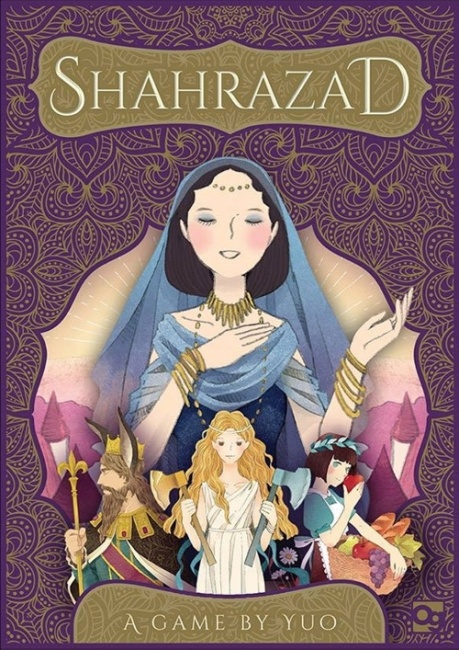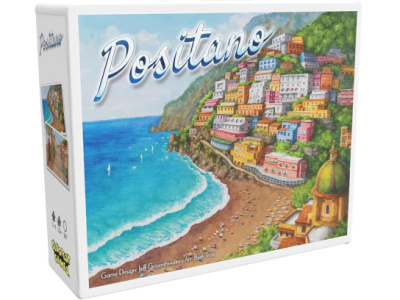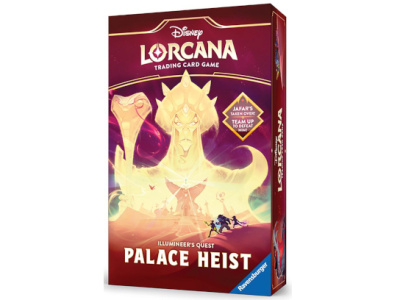Shahrazad
Publisher: Osprey Games
Release Date (US): May 20, 2017
Price: $20.00
Game Designer: Yu Ogasawara
Format: Tile/Card Game
Number of Players: 1 or 2
Playing Time: 20 minutes
Age Rating: 12 and up
ISBN: 978-1-4728-2305-2
ICv2 Rating: 4 Stars out of 5
Solo and cooperative games are often more “puzzle” than “game.” There’s usually some “perfect solution” that solves the puzzle, and once it’s been found the game quickly loses interest. Random elements can mitigate this to some degree or another, but too much and the game is little more than an exercise in luck. The question is, does Shahrazad manage to tell a story that avoids both of those pitfalls?
Summary: Shahrazad is at heart a tile placement style game. The tiles are meant to represent parts of a story, and the tableau is a tapestry of tales woven together. In order for the stories to make sense, they must follow a plot, represented by the numbers on the tiles. So, your challenge is to play the tiles such that the number always increase in value going left to right across the tableau. The twist is that you only have two tiles to choose from each turn, so you must plan ahead carefully and avoid getting trapped in a tale that you cannot finish!
Originality: The tile laying mechanic is familiar and well-proven, but that doesn’t mean that Shahrazad is without new ideas. Particularly worthy is the fact that the game can be played solo or as a two-player cooperative, and the experience between the two playing modes feels remarkably different. Solo, the game plays more like a challenging puzzle. Two-player, on the other hand, is more about communication and mutual understanding, which makes Shahrazad a great “honeymoon game.”
Presentation: As mentioned, the tiles are beautiful. Inspired in equal parts by the major arcana of the Tarot and fairy tales from all over the world (bonus points to anybody who can identify every tale depicted on the tiles!), each tile has a delightful picture that helps evoke the tale-teller theme. The graphic design of the tiles and the box all carry through a lovely middle-eastern feel perfectly appropriate to the Thousand Nights and a Night tales.
However, the small box and the subtle color palette does make the game a bit of a shrinking violet. It could be great for an impulse buy section on the counter, but I fear it might get lost on a heavily-populated game shelf.
Quality: In a word: excellent. The tiles are fabulous. Very thick and sturdy they will stand up to play for a long time. True, Osprey could have used playing cards instead of tiles, but the weight of the tiles in the hand and the sound they make when shuffled enhances the tactile experience of the game in a way that mere cards never could. The box is the strong, well-built style that we have come to expect from Osprey, with a well-written description on the back. Sadly, though, there is no illustration on the outside of the box to showcase the fabulous artwork within. The game rules are brief and clear, though they would have benefited from more examples.
Marketability: Solitaire and two-player games have been a challenge, historically. By their nature they do not benefit from the social and communal aspects of the board gaming hobby, the way multi-player games do. But we have been seeing more and more good games for this category in recent years, and Shahrazad continues this trend. The high quality components do appear to have driven the price up a bit, but it’s still competitive with a night at the movies.
Overall: Shahrazad is an interesting challenge as a solitaire game, with enough randomness to stymie a perfect solution yet enough control that skill will win out more often then not. The urge to “beat your last score” is strong, particularly as getting a perfect store would require an unlikely combination of skill and luck together. It’s even better as a two-player cooperative, requiring the smarts of the solo version plus strong communication skills.
Either way, it’s a game well worth coming back to, which is what I seek in a game like this. And that’s why I’m giving this game 4 out of 5.
-- William Niebling

ICv2 Stars: 4 (out of 5)
Posted by William Niebling on May 4, 2017 @ 5:31 am CT
MORE GAMES
With 'Fanzone: Electronic Football Trivia Game'
July 18, 2025
Ultra PRO will release Fanzone: Electronic Football Trivia Game into retail.
Booster Set Adds King Ghidorah, Gigan, and Spacegodzilla
July 18, 2025
Bushiroad announced a second booster set for Godzilla Card Game.
MORE REVIEWS
ICv2 Stars: 4 (out of 5)
July 11, 2025
Here's a review of Positano, published by Slugfest Games.
ICv2 Stars: 3.5 (out of 5)
June 20, 2025
Check out the review of Disney Lorcana TCG: Illumineer's Quest - Palace Heist, from Ravensburger.








